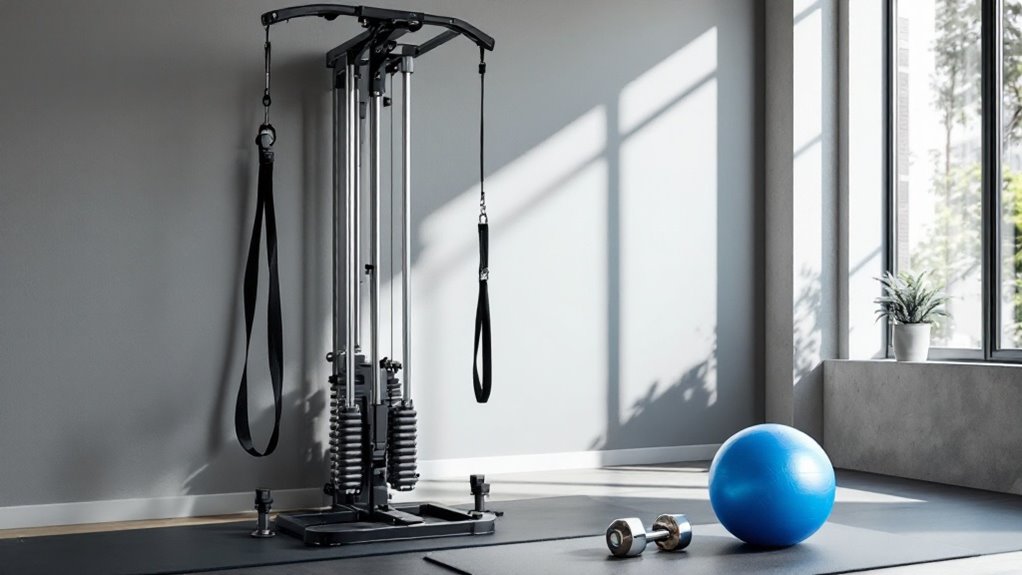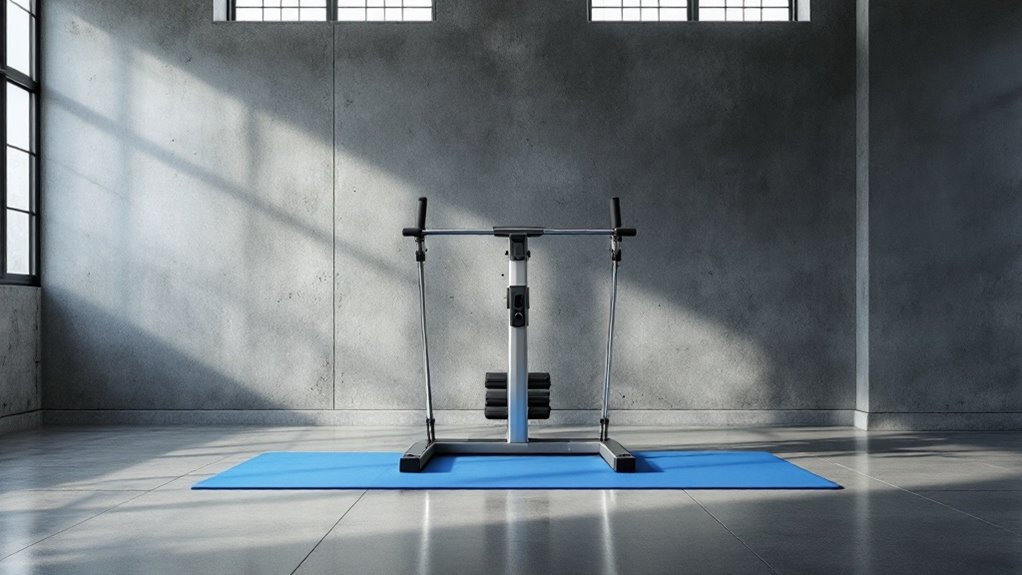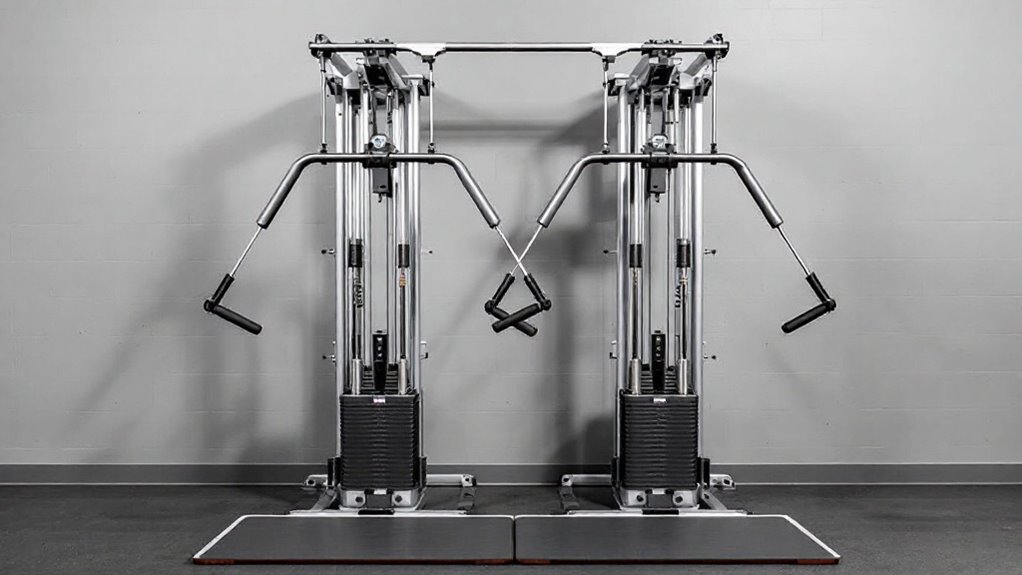Standing Chest Exercises

Standing chest exercises offer effective muscle-building options without requiring complex equipment. Key movements include resistance band presses, cable chest presses, and medicine ball throws, all performed with proper form and progression. Essential equipment includes resistance bands, cable machines, and lightweight dumbbells. Proper technique demands shoulder-width stance, activated core, and controlled breathing patterns. The journey to a stronger chest begins with mastering these fundamental movements.
Key Takeaways
- Standing cable chest press engages both pectoralis major and stabilizer muscles while promoting natural movement patterns.
- Resistance band chest presses provide consistent tension throughout the motion and can be performed anywhere with minimal equipment.
- Medicine ball chest throws develop explosive power while engaging the entire chest muscle group in a functional movement.
- Standing dumbbell chest flyes isolate the pectoralis muscles while challenging core stability and balance.
- Maintain proper form with feet shoulder-width apart, shoulders back, and core engaged during all standing chest exercises.
Essential Equipment for Standing Chest Workouts

While some chest exercises require complex gym equipment, a highly effective standing chest workout can be accomplished with minimal gear. Essential items include resistance bands of varying tensions, a sturdy doorway pull-up bar, and lightweight dumbbells.
For advanced training, adjustable cable machines and suspension trainers like TRX systems can enhance the intensity. A solid pair of athletic shoes provides the necessary stability for explosive movements, while a mirror helps maintain proper form.
Optional but beneficial equipment includes exercise mats for floor shifts, workout gloves for grip support, and a timer for tracking rest periods between sets. Following a monthly workout calendar helps ensure proper progression and recovery when incorporating these standing chest exercises into your routine.
Top Standing Chest Exercise Movements

Although bodyweight exercises form the foundation of many chest routines, standing chest movements offer unique advantages for developing upper body strength and muscle definition.
These exercises involve multiple muscle groups while improving functional strength and stability. Standing movements integrate core activation and real-world movement patterns that translate to daily activities and sports performance.
- Standing cable chest press – targets the pectoralis major while involving stabilizer muscles
- Resistance band chest press – portable option for consistent tension throughout movement
- Medicine ball chest throws – develops explosive power and athletic performance
- Standing dumbbell chest flyes – isolates chest muscles while challenging balance and control
For those with limited equipment, home gym users can effectively build chest strength through standing variations that require minimal setup.
Form and Technique Guidelines

Proper form serves as the cornerstone for maximizing results and preventing injury during standing chest exercises. When executing movements, maintain a solid stance with feet shoulder-width apart and core activated.
Keep shoulders back, chest up, and maintain neutral spine positioning throughout each exercise. Control the weight through full ranges of motion, avoiding momentum or swinging motions.
Breathe rhythmically – exhale during exertion and inhale during the eccentric phase. Focus on squeezing the chest muscles at peak contraction points.
For cable exercises, position the body at ideal angles to create constant tension. Always warm up thoroughly before increasing weight loads.
Following progressive overload principles is essential for continuing to build chest strength over time.
Programming and Progression Tips

Strategic programming improves the effectiveness of standing chest exercises through systematic progression and thoughtful workout design.
Similar to mastering stability ball exercises, maintaining proper form is essential before increasing intensity in any movement pattern.
Proper programming considers volume, intensity, and frequency while gradually increasing demands on the muscles to promote continued growth and strength development.
- Begin with 2-3 sets of 12-15 reps for each exercise, focusing on mastering form before increasing weight
- Progress by adding 5-10% more weight when current sets become manageable
- Incorporate progressive overload by increasing either reps, sets, or resistance every 2-3 weeks
- Alternate between high-rep endurance work (15-20 reps) and lower-rep strength focus (8-12 reps) for balanced development
Frequently Asked Questions
Can I Build a Massive Chest With Only Standing Exercises?
Building a massive chest exclusively through standing exercises is possible but suboptimal.
While exercises like standing cable flyes, resistance band presses, and wall pushups can activate chest muscles, they typically provide less mechanical tension and range of motion compared to traditional bench exercises.
For maximum chest development, incorporating horizontal pressing movements and exercises that allow progressive overload will yield better results.
How Long Should I Rest Between Standing Chest Exercises?
Like a well-oiled machine, rest periods between chest exercises should be precisely timed.
For intense standing chest movements, 60-90 seconds is ideal for strength gains, while 30-45 seconds maintains muscular endurance.
Advanced athletes can reduce rest to 30 seconds for increased intensity.
Proper rest guarantees muscle recovery and peak performance for subsequent sets, maximizing chest development and preventing fatigue-related form breakdown.
Are Standing Chest Exercises Better for Functional Strength Than Bench Exercises?
Standing chest exercises and bench exercises each offer unique benefits for functional strength.
Standing movements better mimic real-world activities and involve more stabilizing muscles, improving balance and coordination.
However, bench exercises typically allow for heavier loads and more targeted chest development.
The most effective approach combines both styles to develop extensive functional strength and muscle mass.
Should I Do Standing Chest Exercises Before or After Shoulder Training?
Ideal training sequence suggests performing chest exercises before shoulders, as the chest is typically the larger muscle group requiring more energy and focus.
However, if standing chest exercises are specifically being used as stabilization or functional training, they can be performed after shoulder work.
The key is maintaining proper form and ensuring fatigue from one exercise doesn't compromise performance in the other.
Can Standing Chest Exercises Help Improve My Posture Throughout the Day?
Standing chest exercises can greatly improve posture by strengthening the pectoral muscles and anterior deltoids, which help maintain proper shoulder and upper body positioning.
When these muscles are strong and balanced, they naturally pull the shoulders back, preventing the common forward slouch.
Regular practice of these exercises creates muscle memory that carries over into daily activities, promoting better spinal positioning and reducing strain on the back.
Final Thoughts
Studies show that incorporating standing chest exercises can increase muscle activation by up to 30% compared to bench-based movements. By mastering proper form, using appropriate equipment, and following strategic progression, these exercises offer a practical way to build strength and definition. Whether using resistance bands, cables, or bodyweight movements, standing chest training provides a versatile approach to upper body development that fits effortlessly into any fitness routine.


